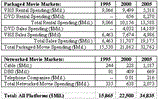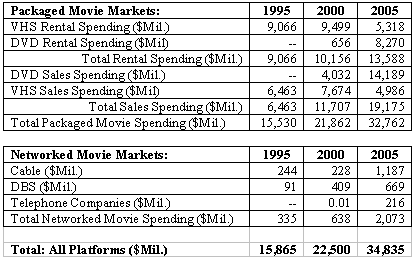Rapid growth of DVD impacts all aspects of video distribution

The sale and rental of digital video discs (DVDs) are exploding this year and will lead to a resurgence of growth for the overall retail movie market in the decade ahead, according to a series of reports prepared by Adams Media Research (Carmel, CA).
After just three years on the market, DVD players are on track to penetrate 12 percent of U.S. homes by the end of this year, making this the fastest roll-out of a consumer entertainment technology since black-and-white television in the 1940s. Those early adopting homes will spend a staggering $4.7 billion renting and buying discs in 2000, up from $1.6 billion last year, according to AMR. AMR's data appear regularly in the newsletters of its publishing partner, GRID Media.
DVD to Comprise Majority of Rentals by 2005
Given the unprecedented levels of consumption the new packaged video format is inspiring among consumers, AMR projects that overall video rental spending (DVD discs & VHS tapes combined), which was $10 billion in 1999, will jump to $13.6 billion by 2005. Video sales, which were $9.2 billion in 1999, will more than double to $19.2 billion during the same time frame. By 2005, 61 percent of video rentals and 74 percent of video sales will come from DVD.
"`Reports of the demise of the packaged movie market have been exaggerated,"' said AMR president Tom Adams. "Digital networks have been threatening to ‘replace the trip to the video store' for nearly a decade now, and by the end of this year nearly 20 percent of U.S. homes will have digital DBS or cable with near-video-on-demand movie service. Yet despite the increased competition and a rather weak slate of films coming to video in recent months, the rental market should grow modestly this year, and sales are on track to explode more than 20 percent."
Pay-Per-View Back From the Dead?
Meanwhile, movie studios are finally starting to see signs of life in the long moribund business of selling movies over networks on a per-view basis. AMR's integrated model of the entire post-theatrical movie market pegs consumer spending on all forms of network-delivered pay-per-view (PPV) at $659 million in 2000, up nearly 30 percent from 1999.
"Clearly the retail and networked forms of in-home film exploitation are now in an era of greater competition with each other,"' Adams said. "But rather than cannibalizing each other, the competitors are forcing each other to better serve consumers, and that's expanding the whole market (see table below for market sector analysis). The two big winners in all this are consumers, and the movie studios who stand to see major incremental gains in overall revenue."
Two examples of better consumer service cited in the AMR reports are:
- On the network side, the upgrading from one- or two-channel pay-per-view to near-video-on-demand packages with as many as 50 channels offering frequent start times of major hits;
- On the retail side, the adoption of revenue sharing distribution models that allow rental stores to stock enough copies to avoid disappointing customers looking for recent hits.
"Ultimately, the impact of the digital disc on the video industry," Adams said, "is likely to be more profound than that of the audio CD on the music industry. In the audio market, unit sales doubled in the ten years after the new format's launch."
VOD on the Horizon
The next new technology likely to bring incremental growth to the studios, according to AMR, is true video-on-demand, an electronic delivery format through which cable companies and telephone companies will be able to serve up particular movies to individual consumer homes whenever they are ordered.
"True VOD has many advantages for consumers," said Adams. "It is just emerging from the labs via cable systems and Internet-based models such as the recently announced Blockbuster DSL service. As it begins to reach wide deployment in the 2005 era, it should grow into a substantial portion of cable's movie revenue stream, and provide the core of a whole new movie market delivered via the telephone company infrastructure.
"The bottom line," Adams said, "is that the studios, by carefully managing release windows and marketing strategies, face a golden opportunity to enjoy robust growth from both their retail and network delivery pipelines in the decade ahead."

Edited by Tom Butts
